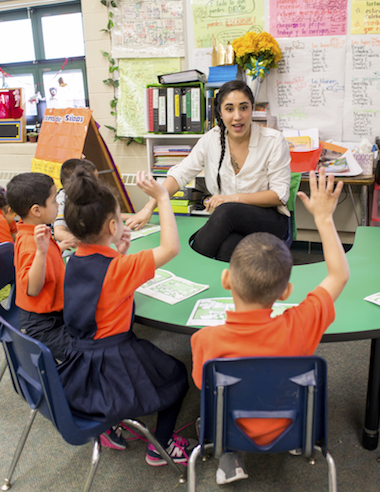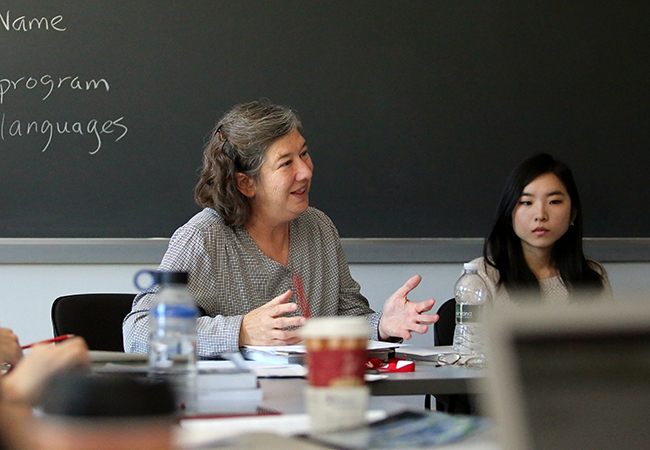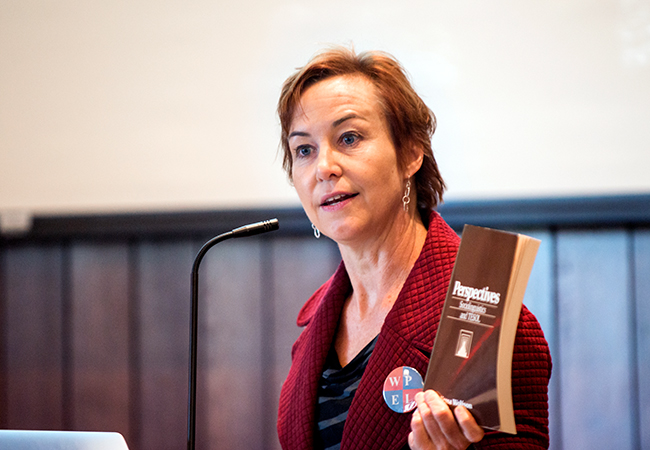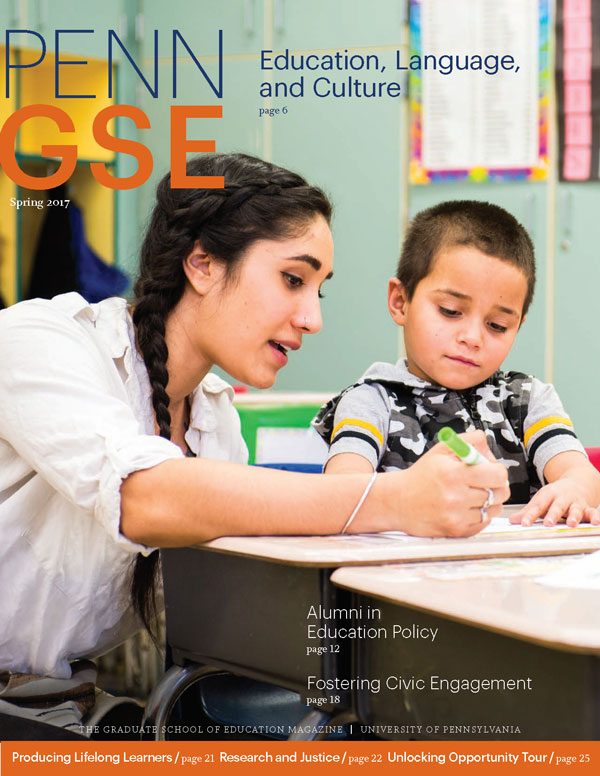Education, Language, and Culture: Penn GSE’s Dr. Nelson Flores Advances Bilingual Education
by Juliana Rosati
As a child attending Philadelphia public schools, Penn GSE Assistant Professor Nelson Flores discovered that in some ways he lived in two worlds. When he unknowingly slipped a Spanish word into his English speech to say he was running from the cuco (boogeyman) or enjoyed watching a novela (soap opera) with his mother, he confronted confused looks or blank stares from his classmates and teachers. Fluent in English, he understood everything his mother said in Spanish at home. But at school, his knowledge of a language other than English had no place.
“I was negotiating such complex linguistic terrain, and yet none of this was incorporated into the curriculum,” he says. “My emerging bilingualism was irrelevant to the school.”
By the end of elementary school, Flores felt unable to speak Spanish due to lack of practice. It wasn’t until high school and college that he found a place for Spanish in his education. “By studying Spanish formally I was able to awaken the bilingualism that had been inside of me since I was a child,” he says.
Today Dr. Flores is working to change how language is taught, as well as how students from Spanish-speaking or bilingual house-holds are perceived. His work has earned him the 2017 Early Career Award given for excellence in advancing the field of bilingual education by the American Educational Research Association’s Bilingual Education Research Special Interest Group.
“A lot of the dominant discourses about children from language-minoritized households—in particular Latino children from bilingual homes—say that the language these students are learning at home is somehow a barrier or is just not applicable to their learning in school,” Flores says.

Research has shown otherwise, revealing long-term benefits of bilingualism for both English language learners and native English speakers. Based on such findings, Flores argues that students with knowledge of Spanish should be viewed as bringing valuable resources to the classroom, rather than possessing deficient or irrelevant language skills. Through his research and his work with Philadelphia schools, Flores hopes to advance understanding of language teaching so that more students can draw upon their linguistic and cultural backgrounds as tools for learning.
The advantages, he notes, extend beyond academic achievement. “Language education is empowering when students’ home language practices are made central to the curriculum,” he says.
Continuing a Linguistic Legacy at Penn GSE
By studying a cohort of students as they progress through a dual-language program at a charter school and supporting The School District of Philadelphia in its efforts to implement dual-language programs in six elementary schools, Flores is taking forward a legacy in the renowned Educational Linguistics division at Penn GSE. The division, now celebrating its fortieth year, has always been dedicated to studying language in the classroom—not only as a subject to be taught, but also as the means through which all learning occurs.
“When you think about it, all teaching and learning is happening through language,” says Professor Nancy H. Hornberger, who recently stepped down as chair of the division after twenty-one years in the role. “Language is also a symbol or an index of identity. We define who we are very much by what we say.”
“Language is also a symbol or an index of identity. We define who we are very much by what we say.”
Dr. Hornberger, recognized internationally as a leading scholar of educational linguistics, including bilingualism and biliteracy, carried out forerunning research on bilingual education in Philadelphia schools with her Penn GSE students beginning in the 1980s. She joined the faculty of Penn GSE in 1985 while the founder of the Educational Linguistics division, the late Dr. Dell Hymes, was dean of Penn GSE. Hymes took the groundbreaking approach of combining linguistic anthropological techniques with education research so that scholars would become long-term observers of day-to-day language use in classrooms and other educational settings. The result was one of the first two educational linguistics programs in the world— and one of only two today in the Ivy League.

“Bilingual children’s lives often require them to do really sophisticated linguistic analysis,” says Flores. One example that Phuong observed in the study was a discussion about frijoles and habichuelas, two words for “bean” in Spanish. Flores says, “When they were only in first grade, some of the students were really thinking about why these two different words are used. They realized maybe it’s because frijoles is from Mexico and habichuelas is from Puerto Rico. No one had taught them that; it was just something they concluded from speaking with classmates of different backgrounds.”
Flores sees that kind of analysis as an often-untapped resource that can help students to accomplish academic goals, including specific aspects of the Common Core State Standards that most states have adopted to some degree.
“The Common Core is asking students to think about how to change language for particular audiences and how to construct language in ways that present yourself for particular purposes,” says Flores. “Our study shows that young children from bilingual homes are already doing this.”
Bringing Best Bilingual Practices to the Classroom
To demonstrate how teachers can formally engage bilingual students’ language insights to meet classroom goals, Flores developed a special reading unit about the children’s picture book Abuela. Written by Arthur Dorros and illustrated by Elisa Kleven, the book tells of a magical journey that a little girl and her abuela (grandmother) take together, flying hand in hand over New York City. The book is written primarily in English, but the grandmother says a number of phrases in Spanish.
The unit, which Flores wrote with two Educational Linguistics alumnae—Holly Link, GR’16, and Swarthmore College professor Elaine Allard, GR’10—uses the book to help teachers lead students through Common Core-aligned reading and writing activities. To test its practicality, Flores asked Carolena Lescano, then a bilingual teacher, to pilot it with her second-grade class at a Philadelphia public school.
“It was a high-quality lesson that I really enjoyed teaching,” says Lescano, now a literacy coach in The School District of Philadelphia. “My students loved it, and we had so many good conversations. They know they’re bilingual, but it’s not so often that we’re using their bilingualism as a fun tool for writing and sharing stories.”
Flores, who formerly taught in the District himself, finds that working with teachers keeps him in touch with the realities of a classroom. Lescano’s feedback, he says, helped him to refine the unit. “I like working with schools because teachers are always going to push for practical tools they can use,” he says.
Flores lost no time in stepping forward to work with District schools on a larger scale when he joined Penn GSE in 2012. The result has been a collaboration over the past four years to support the District’s initiative implementing dual-language programs in six schools: Lewis Elkin, Cayuga, Alexander K. McClure, Hon. Luis Muñoz-Marín, Bayard Taylor, and Southwark.
The first five schools are located in North Philadelphia neighborhoods with predominantly Latino communities. Most of these had “transitional bilingual education” programs, meaning Spanish-speaking students were taught English, but their Spanish skills were not maintained. In response to research on the benefits of bilingualism, changing demographics, and interest expressed by parents, teachers, and administrators, Muñoz-Marín had begun piloting a dual-language program, and the District decided to do the same in the other four schools.
“We were really seeing the need to continue with Spanish literacy, with the goal being both English and Spanish literacy,” says Allison Still, GED’10, deputy chief in the District’s Office of Multilingual Curriculum and Programs. “We had more families who were third or fourth generation, so they were coming from bilingual homes and weren’t qualifying as English language learners.”
The change alters how Spanish-speaking students’ skills are valued in the classroom, according to Flores. “Transitional programs are remedial programs internationally that have that kind of focus.” According to the division’s current chair, Professor Betsy R. Rymes, that focus means offering degree programs that prepare educators to communicate across cultures.

The division’s focus also means studying the relationship between language use and perceptions of academic success. When only one way of speaking is valued in the classroom, Dr. Rymes explains, students may be seen as unsuccessful on the basis of their linguistic and cultural backgrounds. “If you don’t deeply examine why some people succeed and some people don’t, inequities just replicate themselves,” she says, citing as an example early research by linguistic anthropologist Katherine Au regarding Hawaiian children’s storytelling styles. “Native Hawaiian children were used to telling stories in an overlapping style, called ‘talking story.’ Teachers who weren’t native Hawaiians would come in and just see this as unruly behavior. They would spend most of their time trying to manage the class rather than recognizing and building on the students’ storytelling skills,” Rymes says.
The aim of recognizing and building on students’ existing language skills has led Flores to conduct a study at a dual-language charter school. Observing a group of students in school settings on a weekly basis from year to year, he and his team, including Penn GSE Ph.D. students Mark Lewis and Jennifer Phuong, document the students’ processes of making meaning as they navigate between languages. The study began when the students were in kindergarten, that treat bilingualism as a deficit, while dual-language programs are enrichment programs that treat bilingualism as a resource that should be developed for all students,” he says.
Southwark School, in South Philadelphia, did not have a transitional program, but launched a dual-language program in response to high community interest. “There was a lot of excitement and interest among both Spanish-dominant and English-dominant students,” says Still.
Flores has offered professional development for language teachers in the programs, helping them identify and pursue specific literacy goals for both languages. Because Pennsylvania does not offer a bilingual certificate for teachers, the training fills a gap for the District. “Most of our teachers don’t come in with training in bilingual instructional practices,” says Still. She notes that Flores’s background as a District student and teacher has been an asset. “He’s immediately able to connect with the school communities and get a lot of buy-in,” she says.
As part of Flores’s team, Dr. Link (who contributed to the Abuela unit) and Penn GSE doctoral student Sofia Chaparro spend time in classrooms with teachers to help them implement Flores’s recommendations. Both draw upon years of experience as bilingual teachers.
Often, they find, it’s the logistics that teachers need the most help with. Lesson planning, class time, materials, and testing all must be approached from the standpoint of two languages.
At one of the schools, for example, the two languages are taught by separate teachers in most grades. Link and Chaparro observe and consult to help the English and Spanish teachers for each grade level connect their efforts.
“As a teacher, you may feel like you have to cover everything in your language every day,” says Link. “But if you can find time to consult with your partner who teaches the other language to the same students, you may discover that you don’t have to cover every- thing, or find ways to reinforce what your partner does.”
That kind of collaboration is often unfamiliar to teachers, Chaparro notes. “It’s not necessarily what teachers are trained to do,” she says.
Additional insight can come when partner teachers review students’ work together. Chaparro says, “A child’s ability in one language is not always obvious to the teacher of the other language. We want to help teachers to see the children as a whole.”
“I think the kind of sustained, focused, yearlong support we’re providing can make a big difference for a teacher.”
The two also work one-on-one with teachers to offer guidance in teaching approaches, such as reading with students in small groups and leading writing workshops. Such customized attention can be rare for a teacher, Link points out. “As a teacher I had professional development, but it was usually a one-size-fits-all approach for a large number of people. I think the kind of sustained, focused, yearlong support we’re providing can make a big difference for a teacher.”Looking to the Future of Bilingual Education
The District aims to offer the dual-language programs throughout elementary school. Adding them to one grade level per year with the help of Flores’s team, it has implemented the programs from kindergarten through third grade so far.
From Still’s standpoint overseeing programs for the District, the success of Flores’s team is evident. “When we started, every school and classroom was figuring out how to implement the programs on its own,” she says. “Nelson and his team have really been able to help us establish some consistency across the different schools and classrooms.”
Parents have the option of enrolling their children in the programs, and at Southwark this has resulted in a wait list. At the schools in North Philadelphia, Still says, the enrollment is moving closer to the District’s goal of a balance of Spanish-dominant and English-dominant students. The District plans to open up a citywide admission process next year for two of the programs so children living outside the school neighborhoods can participate. “I think a lot of people are really interested in bilingual education and understand how important it is, but they may not realize these programs are available in public schools,” she says.
Flores hopes families will take a broad view of the programs’ benefits. In addition to increased academic achievement and the empowerment that comes from building on their existing language skills, he explains, students from Spanish-speaking families gain the opportunity to continue communicating in Spanish with their parents, and their parents gain ease in communicating with the school. Students whose primary language is English gain a second language, and all students may learn about diversity.
“I hope seeing bilingualism treated as normal in the classroom helps children understand that diversity is not something to be afraid of,” Flores says. “Learning to navigate diversity and see it as just a part of life is something that all students would bene t from.”
Looking ahead, Flores hopes his work can establish an even broader perspective for bilingual education—one that addresses obstacles, such as racism and poverty, that many students in bilingual programs face outside of school. To this end, Flores is exploring how to use research from another field, urban planning, in his work. While such an interdisciplinary approach may not be typical for a scholar of bilingualism, Flores knows that Penn GSE’s Educational Linguistics division—born of Dell Hymes’s combination of linguistic anthropology and education—is the right place to attempt it.
“The faculty here have always understood that the issues we face require a multifaceted toolkit,” he says. “When I tell my colleagues I’m thinking of bringing in another disciplinary perspective, they don’t say, “No, we’re only education scholars, we’re only anthropologists. They say, ‘Sure, why wouldn’t you do that?’”
This article originally appeared in the Spring 2017 issue of The Penn GSE Magazine.

